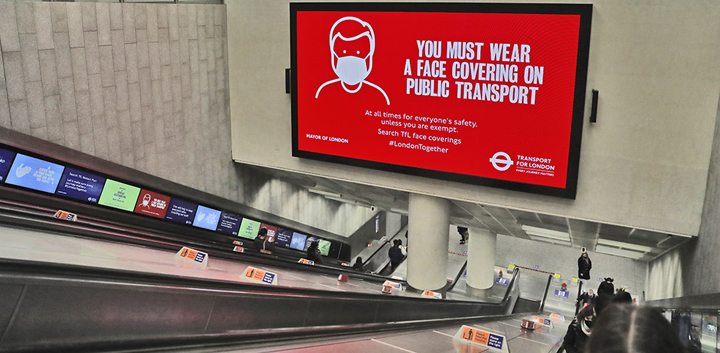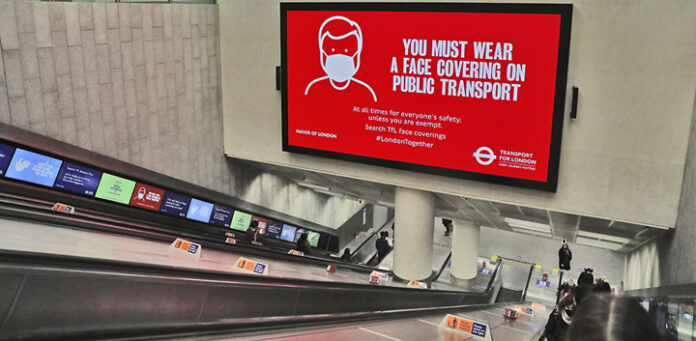LONDON—When London came to a stop as a nationwide coronavirus lockdown was imposed a year ago, the Underground kept running as an essential service. But it was a strange and unnerving experience for its workers.
Joseph Cocks, a driver on the subway’s Circle Line that loops around the city center, said he could “count the number of people who got on the train on one hand.”

“To see it on a Monday morning peak, to see hardly anyone about, was shocking and surprising,” he said of the system that opened in 1863 and is known colloquially as the Tube.
Its continued operation was a sign that even in a pandemic, London’s heart was still beating.
In a city where almost half of households don’t own a car, public transit keeps economic and social life moving. Before the nationwide lockdown on March 23, 2020, about 5 million journeys a day were taken on the Tube. Its iconic map, reminiscent of a multicolored circuit board, is both an emblem of the city and an essential tool for residents and visitors alike.
In the early weeks, when most Britons were told to stay at home and fear outpaced facts about the virus, Underground employees kept going to work, but worried about getting sick.
“We didn’t know exactly how bad it was,” Cocks said. “There were worries about how dangerous this job was, and you’d hear stories of people on the Underground catching coronavirus. So we didn’t know how fast it spread and how safe we were.”
Initial casualty count
COVID-19 has taken a heavy toll on Transport for London (TFL), which runs the city’s subway, suburban rail and bus network. At least 89 TFL staff have died from the coronavirus, most of them bus drivers, whose death rate has been three times the national average, according to a study by University College London.
The virus has hit people in public-facing jobs hardest, and the death toll has been higher among ethnic minorities than their white compatriots. The reasons are thought to include jobs, underlying health conditions and economic inequality.
About a third of the TFL workforce belongs to an ethnic minority, in part a legacy of the thousands of people from Britain’s former colonies who came to the UK after World War II to bolster a depleted workforce.
Brian Woodhead, the Underground’s director of customer services, says the network acted quickly to protect staff and passengers. Masks are mandatory, hand sanitizer is plentiful, escalator handrails are blasted with virus-killing ultraviolet light and one-way systems reduce logjams in station corridors. On buses, drivers sit in sealed-off cabs.
“As much as anyone can in the circumstances that we now find ourselves in, I think that the Tube is a safe environment,” Woodhead said.
He cites a recent study by Imperial College London, which tested for the virus on surfaces and in the air on the Underground and found none. That is due in part to people like Ivelina Dimitrova, who supervises 20 cleaners at stations, including the busy King’s Cross. She and her crew—mostly immigrants from Eastern Europe, Africa and south Asia—regularly spray surfaces with hospital-grade disinfectant.
“We had to change our work routine and everything, and [had] to do it fast” when the virus arrived, she said, adding that they felt constant stress about getting infected.
Do what we have to do
NOW, she said, “we have strong morale, because we feel that we have to do what we can do just to keep ourselves safe, our families safe, other people around us safe.”
Passengers who previously took little notice of the cleaning staff now sometimes stop to thank them, she said.
The pandemic has left the world’s oldest subway system facing an uncertain future. The Tube, which relies heavily on ticket revenues, faces a cash crisis. Ridership plunged to just 4 percent of pre-pandemic numbers early in the outbreak and now carries about a fourth of the passengers it did before the outbreak.
During one recent rush hour, a trickle of passengers hustled through the ticket gates at the usually teeming Victoria and King’s Cross stations, past posters reminding travelers to wear face coverings and “Be Kind” to one another.
Keeping London moving
PRIME Minister Boris Johnson has set the country on a slow path out of lockdown, with hairdressers and shops scheduled to reopen April 12. But people are still advised to work from home if they can and to take the Tube only if needed.
His government has given Transport for London about £4 billion ($5.6 billion) in grants and loans to keep it running, although the money is due to run out on May 18. Talks on funding have been clouded by acrimony between Johnson’s Conservative government and London Mayor Sadiq Khan, a member of the Labour Party.
Woodhead expects ridership to increase, but “whether that’s 18 months or whether it’s 36 months” is hard to predict. And the pandemic may have changed travel patterns for good, with more walking and cycling and less rush-hour commuting.
In December, an independent report commissioned by TFL and the mayor said a “credible” forecast was that there would be a 20 percent reduction in demand for public transit due to “travel changes and economic weakness” after the pandemic.
“People won’t, I doubt very much, commute five days a week,” Woodhead said.
“Some people will. But there’ll be a lot of people now that do it in a hybrid way. That’s surely going to happen, which on one side will help from a congestion point of view, but the other side won’t help from a revenue point of view.”
Still, Woodhead is confident the Tube will be a key part of London’s recovery.
“It’s just interwoven into the whole infrastructure and the way in which London works,” he said.
Meanwhile, drivers like Cocks will keep doing a job that has become “a bit more secluded, a bit more isolated.”
“It’s nice to know that you’re keeping London moving,” he said. “You’re doing your bit to keep everything going from A to B.”
Image credits: AP/Alastair Grant
Read full article on BusinessMirror

